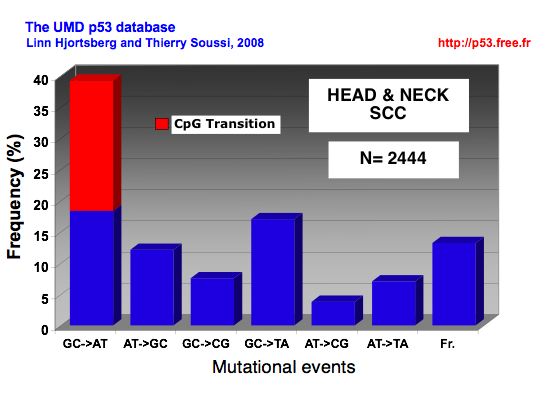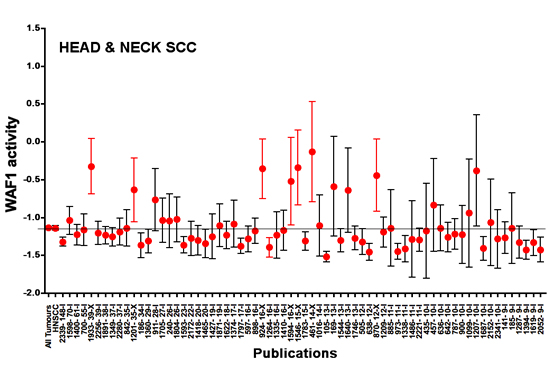| |
p53 database
p53 database
Database curation
Download the database
Improve p53 mutation detection and report
p53 mutation and cancer
|
p53 MUTATIONS IN HEAD AND NECK CANCER
Blons, H. and Laurent-Puig, P. (2003) TP53 and head and neck neoplasms. Hum Mutat, 21, 252-257..-> Download
Head and Neck cancer
Head and neck cancer is the term given to a variety of malignant tumors that develop in the
oral cavity (mouth);
pharynx (throat);
paranasal sinuses (small hollow spaces around the nose lined with cells that secrete mucus);
nasal cavity (airway just behind the nose);
larynx ("Adam's apple" or voice box); and
salivary glands (parotid, submanidular, sublingual glands that secrete saliva).
It is also possible to include skin tumors of the face and neck and tumors of the cervical lymph nodes.
Risk Factors
Factors known to contribute to the risk of developing head and neck cancers include smoking (both tobacco and marijuana) or chewing tobacco and alcohol use. Leukoplakia (white spots or patches in the mouth) also may be considered a risk factor, as this condition becomes cancerous in approximately one-third of patients.
Pathology
Most head and neck cancers are squamous cell carcinomas, tumors that develop in the tissue lining the hollow organs of the body. However, other tumor types also may be seen and include lymphoepithelioma, spindle cell carcinoma, verrucous cancer, undifferentiated carcinoma and cancers of the lymph nodes, called lymphoma (most often diffuse non-Hodgkins lymphoma)
Spectrum of p53 mutations in Head and Neck cancer
 |
DISTRIBUTION OF p53 MUTATIONS IN HEAD AND NECK CANCER |
 |
MUTATIONAL EVENTS IN HEAD AND NECK CANCER |
|
Meta-analysis of p53 loss of function in HNSCC.
Points ; mean p53 activity as measured by transactivation with the WAF1promoter ; bars , 95 % CI. The mean and 95 % CI of p53 activity for all studies combined for a specific type of cancer is shown on the far left of each graph.
Horizontal line, mean of the combined studies. The publication code is indicated on the x-axis : the first number is an anonymous ID for the publication and the second number indicates the number of p53 mutants included in this study. Studies are presented from left to right in decreasing order of number of p53 mutants. The y-axis corresponds to p53 transactivation activity, with a value of 1.5 for the negative control and a value of 2.5 for 100 % of wild-type activity. Only studies with 5 or more p53 mutations are shown on the graph.
More information about this statistical analysis can be found in this article:
Soussi, T., Asselain, B., Hamroun, D., Kato, S., Ishioka, C., Claustres, M. and Beroud, C. (2006) Meta-analysis of the p53 mutation database for mutant p53 biological activity reveals a methodologic bias in mutation detection. Clin Cancer Res, 12, 62-69. Download the pdf
|
|
|









